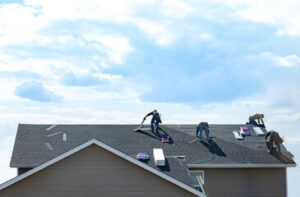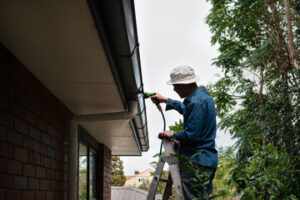A roof is the shield that protects a house against blazing sun, pounding rains, and gusty winds. It also adds beauty and curb appeal to a property.

Roof installation is a complex process. It requires a team of experts to do the job right. To minimize disruptions, homeowners need to prepare for a new roof by moving outdoor furniture and covering landscaping with tarps. Visit https://redstickroofing.com/baton-rouge to learn more.
The installation of a new roof starts with the preparation of your property. An expert roofing team will talk you through the materials and options that make sense for your goals, architecture and budget. Once you’ve decided, the roofer will order the roofing material and schedule its delivery.
During this part of the process, it’s crucial that your yard and patio remain clear. The roofing crew will need to move around furniture, grills, potted plants and lawn ornaments so they can safely access your home’s exterior. If you have children, consider making arrangements for them to stay with friends or family during the roof replacement. The loud noises and construction equipment can be unsettling for kids, and metal flashing can cut or scratch them if they touch it.
You’ll also want to remove any outdoor items that are too close to the house, such as garden tools or shed contents. This will prevent your belongings from becoming strewn about the yard and potentially damaged by falling shingles or debris during the roof replacement. It’s also a good idea to cover any areas of your landscaping that will be exposed during the roof replacement, such as flower beds or paved areas. Using tarps is a cheap and effective way to protect these areas from the elements.
A top-tier roofing team will take care to remove any aging or damaged shingles and decking from the old roof before starting on the new one. They’ll also take this opportunity to inspect the roof deck and make sure it’s strong enough to support the weight of a new roof. This inspection is important to avoid any surprises down the road and to guarantee a long-lasting roof that will protect your home for years to come.
Once the old roof is removed, the roofing crew will set up the underlayment and start installing the shingles. Whether you opt for asphalt or metal, your roofer will add the shingles in layers, staggered and nailed. This step also involves the installation of a drip edge, flashing and any other architectural features that are necessary for protecting your home from moisture intrusion.
Materials
When you hire a professional to install your roof, make sure they have the necessary materials. Nothing ruins a roofing job faster than having to stop the work to go to the hardware store for something you forgot. Make a list of all the items you need to complete the project and keep it handy so you don’t forget any essentials.
Roofing contractors will need plenty of materials to tear off the old roof and install the new one, including plywood boards that form the base of your roof’s structure. They’ll also need underlayment, which is a waterproof layer that protects the wood decking and wooden rafters or wooden trusses on which the main roofing material will be installed.
Other necessary roofing materials include shingles or other material that creates the aesthetic you’re going for and is durable against weather conditions in your area. Asphalt shingles are common because they’re inexpensive and provide good protection against the elements. Wood shingles like cedar shakes and pine shingles are high-end options that are long-lasting and beautiful, but they’re more expensive. A metal roof is another option that’s durable and comes in a variety of styles. Metal shingles are small and fit easily around chimneys or other features, while corrugated metal panels and standing seam metal roofs are more durable and long-lasting.
To make your roof more water-resistant, you can have flashing and drip edge installed. This is a non-corrosive piece of metal that is placed along the edges of your roof where it meets other areas or structures, such as a vent, skylight, or chimney. It directs water away from those areas to prevent leaks in the wood decking.
You can also have a copper roof or other types of metal roofs to provide an elegant, attractive look. Slate is also an option but is very expensive and requires special care to keep it in good condition.
You’ll want to prepare the area outside your home for the work by pruning any trees that encroach on the roof or are too close to it, and moving any outdoor furniture, ceramic landscaping features or other items that might be damaged by falling shingles. Invest in large tarps to cover plants and other items that you can’t move, or at least pound protruding nails flat so they don’t tear holes in the tarps when it rains.
Installation
The installation of a roof is the process of covering the top of a building with durable and protective materials. The roof is designed to shield the structure from rain, snow, sunlight, wind and extreme temperatures. It also adds aesthetic appeal and value to the home.
The first step in roof installation is to prepare the work site. This means removing anything that could get damaged or swept away, covering surrounding areas with tarps and ensuring that everyone working on the roof is wearing appropriate safety gear. In addition, it is important to make sure the weather is cooperating by checking the forecast frequently. Rain or ice can make it unsafe to be on the roof, and it may be necessary to delay the project until conditions are favorable.
Once the roof is clear, the contractor will begin installing the underlayment and shingles. The underlayment is an additional layer of protection that prevents water from seeping through to the underlying layers. The shingles are then installed over the underlayment and fastened down with cap nails. The drip edge is then nailed down to the underlayment and to the existing roofing, and the ice and water barrier is nailed down along the edges.
Before the shingles are installed, the roofer will inspect and replace any flashing that is worn or damaged. This is usually made of aluminum or galvanized steel, and it is installed over joints in the roof to prevent water leakage. The flashing around the chimney, skylights and vents will be inspected as well. It is important to have high-quality flashing in these areas to ensure a waterproof seal.
After the shingles are in place, the roofer will install any vents that are needed for the structure. This can include ridge vents, gable vents and roof penetrations such as sewer vents, curve vents for bathrooms and kitchen ranges and more. It is important to install these correctly, and the roofer will often use a metal caulking to ensure a strong and long-lasting seal.
Once all the new materials are in place, the roofer will install a ridge cap to finish off the shingles and prevent water from entering the structure. The ridge is the peak of the roof, and it is capped with special shingles that are installed over the top of the shingle row. The ridge is then sealed to the rest of the roof with a bead of roof cement.
Inspection
Choosing high-quality roofing materials is important, but they won’t be able to do their job if they aren’t installed properly. That’s why a roofer will conduct an inspection before beginning work to make sure everything is in order. In addition to looking for shingles that are cracked or buckling, they’ll also check the caulking and flashing around penetrations like skylights and chimneys for damage.
Then they’ll go inside the house and examine ceilings and walls near the roof for signs of water leaks. These might include stains or discolored drywall, which can indicate that the roof is leaking. They’ll also look for missing or curled shingles, as well as moss and rust on the decking.
If they have access to the attic, they’ll inspect its condition and rafters, joists, and fascia boards for signs of rot. They’ll also check for sagging or uneven roof planes and examine gutters, downspouts, and soffit vents to make sure they’re in good shape and that they’re adequately ventilating the roof.
Leaking and moisture are the most common problems with roofs. To prevent them, a roofer will look for things such as curling or loose shingles, shingle granules in the gutter, and moss and lichen on the decking. The roofer will also determine the condition of the roofing material to see if it has reached the end of its life and will need to be replaced or repaired.
One of the best tools that a roofer has is a thermal imaging camera. This device can show areas of heat loss by showing two distinct colors – blue means cool air is escaping, and red indicates hotter air is coming in. Once the roofer locates these hot spots, they’ll be able to pinpoint the source of the leak and take the necessary steps to fix it. If they can’t get on the roof for any reason, such as weather or safety concerns, a drone inspection may be used instead. This method is also useful for examining roofs that are very steep or inaccessible.
